When it comes to restroom breaks, office workers in the U.S. say that touchless restroom fixtures are the number one feature that would make them feel safer when using their workplace restroom. According to the Healthy Handwashing Survey™ by Bradley Corp., touch-free washroom fixtures received the highest safety ranking, followed by access to well-stocked supplies such as soap Read more
Bradley Corp.
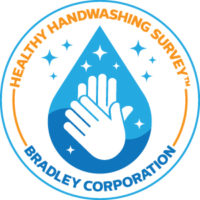
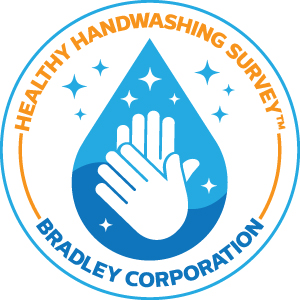 When it comes to restroom breaks, office workers in the U.S. say that touchless restroom fixtures are the number one feature that would make them feel safer when using their workplace restroom. According to the Healthy Handwashing Survey™ by Bradley Corp., touch-free washroom fixtures received the highest safety ranking, followed by access to well-stocked supplies such as soap and paper towels; a clean, disinfectant smell; sufficient space for social distancing; and posted signage with the restroom’s cleaning schedule.
When it comes to restroom breaks, office workers in the U.S. say that touchless restroom fixtures are the number one feature that would make them feel safer when using their workplace restroom. According to the Healthy Handwashing Survey™ by Bradley Corp., touch-free washroom fixtures received the highest safety ranking, followed by access to well-stocked supplies such as soap and paper towels; a clean, disinfectant smell; sufficient space for social distancing; and posted signage with the restroom’s cleaning schedule.
Not only do they associate touchless fixtures with a safer restroom environment, office workers view them as must haves. Nearly four-in-five (79%) of office workers believe no-touch fixtures are an important feature in workplace restrooms. Among the general U.S. population, this sentiment is even higher – 84% say they are important in public restrooms.
“Interestingly, two-thirds of office workers use a paper towel to avoid touching restroom door handles, flushers and faucet handles,” said Jon Dommisse, vice president of marketing and corporate communications, Bradley Corp. “This evasive action further demonstrates why touch-free restroom fixtures resonate so much with restroom users.”
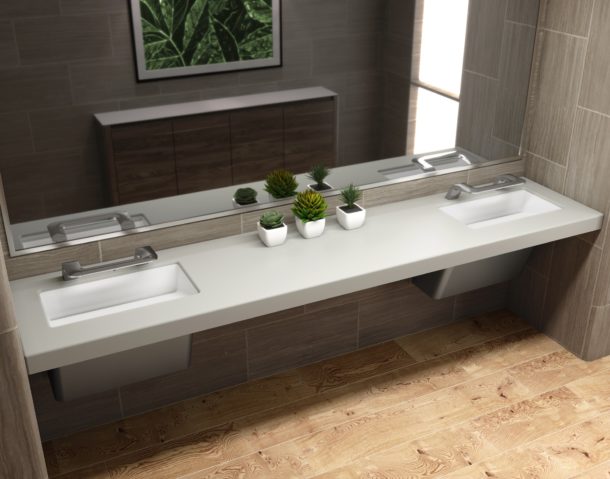
Handwashing is also top-of-mind for office workers, as 70% report washing their hands more now because of new Covid strains, such as the Delta variant. Overall, half of office workers are washing their hands six-plus times a day.
“Just as 9-11 changed air travel and the iPod changed how we listen to music, Covid has changed how we view handwashing and washrooms,” Dommisse said.
Rating the condition of workplace restrooms
The survey also shows 75% of office workers believe the condition of a workplace restroom is one indicator of how a company values its workforce. Fortunately, 68% of office workers rate their restrooms as excellent or very good.
That’s not to say office workers don’t experience problems with workplace restrooms. 81% have encountered at least one issue while using them. The most annoying issues – cited by 62% of workers – are empty or non-working soap, paper towel and/or toilet paper dispensers. Another 62% are concerned with restroom cleanliness.
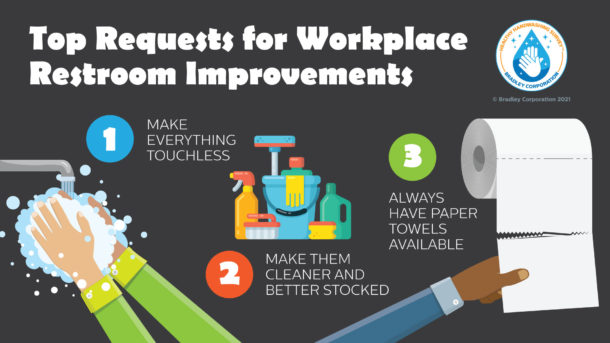
Highlighting office hygiene improvements
Most employers (62%) have made improvements to make employees feel safer returning to work amidst the pandemic with upgrades such as adding hand sanitizing stations around the office (66%), cleaning offices and restrooms more frequently (65%) and encouraging employees to stay home while they’re sick (51%).
Interestingly, only 42% of companies have communicated these changes to their employees.
Sharing these improvements positively impacts employers since 53% of office workers say their employer’s response to the pandemic makes them feel more valued, 50% say it shows the company cares about its employees, and 35% say it makes them feel more positive about their company.
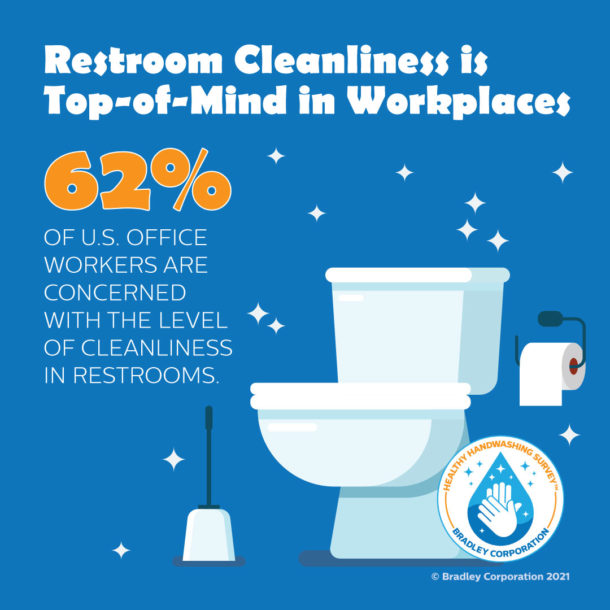
The Healthy Handwashing Survey from restroom equipment manufacturer, Bradley Corp., queried 1,035 American adults Aug. 3-10, 2021, about their handwashing habits, concerns about the coronavirus and their return to the workplace. A subset of 513 respondents who work in offices were identified and asked a series of applicable questions. Participants were from around the country and were evenly split between men and women. The Healthy Handwashing Survey of the general population has a margin of error of +/- 3% and the office worker subset has a margin of error of +/- 4%, with a 95% confidence level.
For more information, visit bradleycorp.com/handwashing.
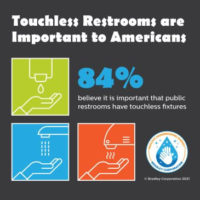
According to a national survey by Bradley Corp., half of the population continued to use public restrooms throughout the pandemic. Just 13% of Americans said they completely avoided using a public restroom while 50% visited restrooms just as they always had. Another 37% said they were uncomfortable but had, at times, utilized a public restroom Read more
According to a national survey by Bradley Corp., half of the population continued to use public restrooms throughout the pandemic. Just 13% of Americans said they completely avoided using a public restroom while 50% visited restrooms just as they always had. Another 37% said they were uncomfortable but had, at times, utilized a public restroom when necessary.
The most common places where Americans used a public restroom were stores, restaurants and their workplace. The majority who visited public restrooms took precautions to reduce their likelihood of coming in contact with germs. 63% had ahold of a paper towel as a protective barrier when they operated the toilet flusher and faucet handles or reached for door handles. Alternately, another group employed their foot to flush the toilet or opened and closed doors with their butt.
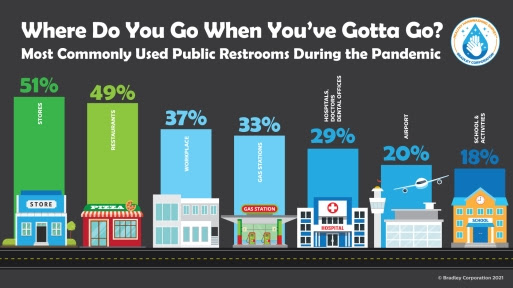
The annual Healthy Handwashing Survey from Bradley Corp. queried 1,050 American adults regarding their public restroom usage, handwashing habits and concerns about the coronavirus and flu. Participants were from around the country and were evenly split between men and women.
Strong Preference for Touchless
Since Americans have relied on evasive measures to avoid germs in public restrooms, it’s not surprising that 84% believe it’s important to have touchless fixtures. In fact, nearly 70% say they’re more likely to return to a business that has touchless restroom features. On the other hand, 56% have a negative impression of a business that doesn’t have touchless fixtures.
When it comes to which fixtures Americans prefer to be touchless, the toilet flusher, faucets and entrance doors top the list.
“Touchless restroom fixtures add a significant level of comfort for Americans when they’re out and about and need to use a public restroom,” says Jon Dommisse, director of strategy and corporate development for Bradley Corp. “We’ve all become more cognizant of potentially germy touch points so eliminating an area of concern is another way we can help resume our normal lives again.”

Germ Concerns Significant
The Healthy Handwashing Survey, which was conducted in January 2021, found that 86% of Americans are more conscious about coming in contact with germs as a result of the Coronavirus.
That concern has led to a spike in handwashing and hand drying. The survey revealed that nearly 90% are washing their hands more frequently or more thoroughly as a result of the Coronavirus. In terms of frequency, 57% are sudsing up between six to 15 or more times a day. And, 73% are drying their hands more frequently or more thoroughly.
That’s significant because hand drying is an important step in the handwashing process. The Centers for Disease Control and Prevention (CDC) explains that, “Germs can be transferred more easily to and from wet hands; therefore, hands should be dried after washing.”
Overall, Americans correctly believe handwashing is a better germ-fighter than hand sanitizer. 61% understand their hands are less germy after washing with soap and water than after using hand sanitizer – a fact supported by the CDC. For times when soap and water are not available, the CDC says that using hand sanitizer is a good, second option for hand hygiene.
“Handwashing remains one of the easiest and most effective ways to stay healthy and reduce the likelihood of spreading germs or viruses to others,” says Dommisse. “When you pair soap and water with vigorous and thorough scrubbing, you’re literally removing and sending bacteria and germs down the drain.”
For more information, visit bradleycorp.com/handwashing.

Bradley Corp., announces the appointment of Mark Whittington to Vice President – Business Development for the Menomonee Falls, Wis.-based manufacturer of plumbing fixtures, restroom accessories and emergency equipment for 100 years. Whittington will join Bradley’s leadership team and in his role be responsible for growing Bradley’s plumbing products business. He has held various sales, operations and supply chain leadership positions in Read more
Bradley Corp., announces the appointment of Mark Whittington to Vice President – Business Development for the Menomonee Falls, Wis.-based manufacturer of plumbing fixtures, restroom accessories and emergency equipment for 100 years.

Whittington will join Bradley’s leadership team and in his role be responsible for growing Bradley’s plumbing products business. He has held various sales, operations and supply chain leadership positions in the plumbing industry for 20-plus years, most notably with Elkay Manufacturing as Executive VP- Plumbing.
“Mark possesses extensive knowledge of the Plumbing Wholesale industry, knows many of our sales representative agencies and the leading wholesaler customers,” says Luis de Leon, Chief Operating Officer, Bradley Corp. “We are excited that he has joined Bradley’s leadership team and is already making a positive impact on our business.”
News coverage, signage and restroom preparedness prompt hand washing behavior If there is some good news in the age of coronavirus, research from the Healthy Hand Washing Survey shows that during the past 11 years an increasing number of Americans are heeding the message about washing their hands to protect themselves from flu outbreaks. The Read more
News coverage, signage and restroom preparedness prompt hand washing behavior
If there is some good news in the age of coronavirus, research from the Healthy Hand Washing Survey shows that during the past 11 years an increasing number of Americans are heeding the message about washing their hands to protect themselves from flu outbreaks. The question then becomes: Are facilities equipped to support hand washing as people return to their regular public activities?
11-year uptick in U.S. hand washing habits
In 2009, the year H1N1 hit the United States, only 45% of Americans said they washed their hands more frequently or thoroughly in response to flu virus outbreaks. By 2019, the number of flu-fighting hand washers in the U.S. had risen to 79%.
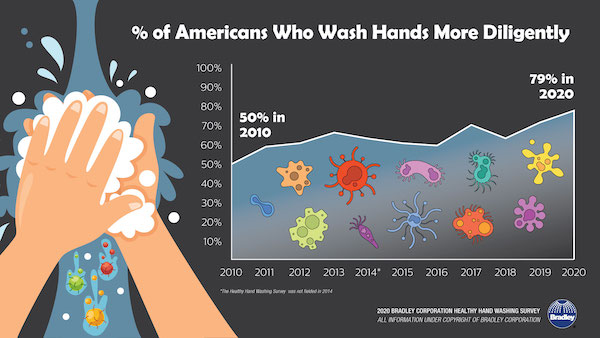
A national focus on outbreaks does have an affect on hand hygiene. 50% of Americans say news coverage of cold and flu outbreaks has a “very large” or “somewhat large” impact on their hand washing behavior. Women and their hand washing habits are more likely to be impacted by news coverage than men (53% vs. 47%).
“The steady rise in hand washing diligence in America may, in part, stem from several stand-out flu seasons over the past decade – particularly flu outbreaks in 2009, 2015 and 2018,” says Jon Dommisse, director of strategy and corporate development for Bradley Corp. “Now, the unprecedented spread of coronavirus has placed an even more intense spotlight on the critical nature of thorough hand washing with soap and water for at least 20 seconds.
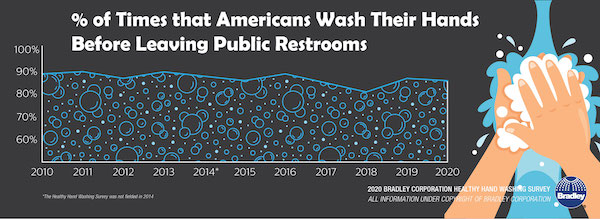
“Hand washing in public facilities will be exceedingly important in the coming weeks and months as people return to workplaces, offices, schools, restaurants, stores and other gathering places,” Dommisse said. “It’s essential we take advantage of every opportunity to wash our hands whether we are at home or in public.”
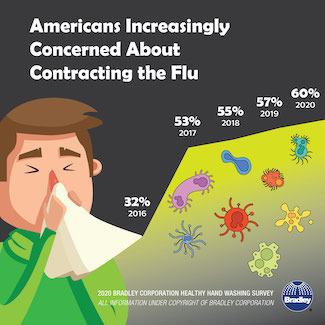 Hand washing in a new era
Hand washing in a new era
According to 11 years of Healthy Hand Washing Survey findings, the following actions encourage hand washing in public restrooms:
- Hand washing signage. Almost 40% of Americans say they’re more likely to wash their hands after seeing a sign that requires employees to wash before returning to work.
- Clean and stocked restrooms. The top two reasons Americans don’t wash their hands after using a public restroom are lack of soap or paper towels (34%) and restroom sinks that are dirty or not working (21%). In addition, 85% of Americans say they hurry to get out of a restroom if the conditions are unpleasant.
- Touchless hand washing fixtures. While keeping them cleaner and better stocked is Americans’ most desired improvement in restrooms, making everything touchless is next on their wish list. People go out of their way to avoid contact with germs in restrooms. 65% use a paper towel to eliminate hand contact with doors and faucets and 44% of people operate toilet flushers with their foot.
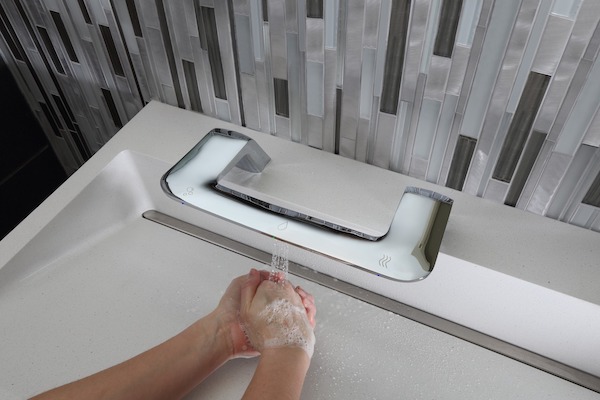
“Hand washing in America has undoubtedly improved over the past 11 years but coronavirus is a real hand washing game changer,” Dommisse said. “We must all remember that hand washing is among the most important actions to protect our loved ones, our communities and ourselves.”
Bradley Corp. is a leading manufacturer of commercial plumbing fixtures, washroom accessories, restroom partitions, emergency fixtures and solid plastic lockers.
For more information, visit www.bradleycorp.com/handwashing.
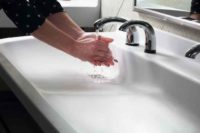
Menomonee Falls, Wis. — For the past 11 years, Bradley Corporation has conducted its Healthy Hand Washing Survey to track American’s hand washing habits and their reactions to germs, the flu and colds. The annual survey queried American adults and youth online Dec. 11-16, 2019. Participants were from around the country, were 14 years and older, and were Read more
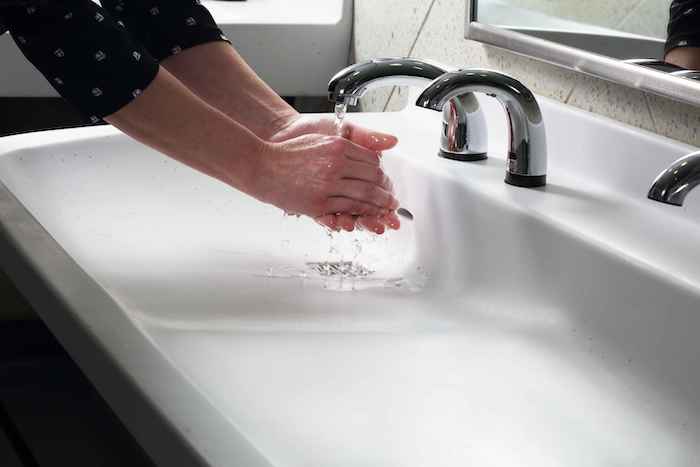
Menomonee Falls, Wis. — For the past 11 years, Bradley Corporation has conducted its Healthy Hand Washing Survey to track American’s hand washing habits and their reactions to germs, the flu and colds.

The annual survey queried American adults and youth online Dec. 11-16, 2019. Participants were from around the country, were 14 years and older, and were fairly evenly split between men and women (47% and 53%).
The findings revealed that:
- Even before COVID-19 hit the United States, 60% of Americans were extremely or quite concerned about catching the flu, compared to just 32% who felt that way four years ago. Among all age groups, Millennials expressed the most trepidation about getting sick.
- 50% of Americans said news coverage of cold and flu outbreaks has an impact on their hand washing behavior.
- In response to flu outbreaks, 79% of Americans said they wash their hands more frequently, more thoroughly or longer after using a public restroom.
- 89% of Americans in the workforce said they consciously take steps to avoid the germs of sick co-workers or colleagues.
- 64% of Americans correctly believe that hand washing is more effective in removing germs than hand sanitizer — a fact supported by the Centers for Disease Control and Prevention.
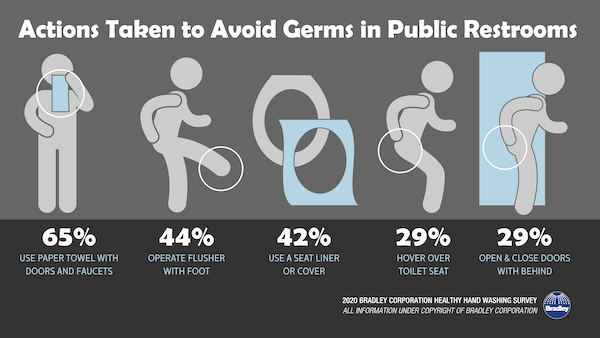
- When asked where they were MOST concerned about somebody not washing their hands, 40% said restaurants, 35% identified hospitals, clinics and doctors’ or dentists’ offices, 15% answered schools and 8% said airports.
- When they are sick, 54% of Americans said they simply wave hello to greet people, 48% avoid shaking hands and 18% use a fist or elbow bump.
- At home, if someone is sick or if a cold or flu virus is going around, Americans kick into action. 65% wipe down bathroom and kitchen surfaces. 47% wipe door knobs and handles. 46% wash sheets and/or towels.
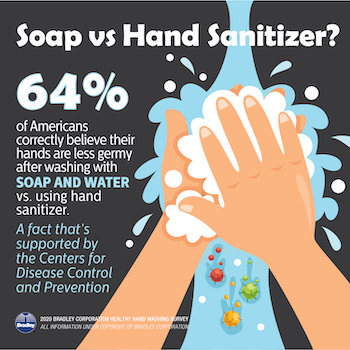
- In a public restroom, 93% of Americans try to avoid coming in contact with germs by employing evasive measures. 65% use a paper towel when touching door handles, faucets or toilet flushers, 44% operate the toilet flusher with their foot, 42% use a seat liner or cover, 29% hover above the toilet seat, 29% use their butt to open and close doors and 27% use their elbow to operate towel dispensers.
- 97% of Americans believe it’s important to wash up after using a public restroom. However, hand washing doesn’t happen all the time. Respondents said they washed their hands 86% of the time after using a public restroom.
- 67% of Americans admit they’ve skipped the soap and simply rinsed their hands with water after using a public restroom.
“Thorough hand washing with soap and water remains the best way to reduce the spread of disease-causing microorganisms like COVID-19,” says medical microbiologist Michael P. McCann, Ph.D., professor of biology, Saint Joseph’s University. “Soap and water, used as per the evidence-based recommendations of the Centers for Disease Control and other government agencies, will help reduce the spread of flu and other illnesses in the home and work place.”
Bradley Corp. is a leading manufacturer of commercial plumbing fixtures, washroom accessories, restroom partitions, emergency fixtures and solid plastic lockers.
For more information, visit www.bradleycorp.com/handwashing.
